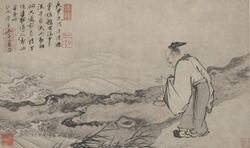Astronomy:River of Heaven


The hazy band of stars of the Milky Way was referred to as the "River of Heaven" or the "Silvery River" in Eastern Asian and Chinese mythology. The River of Heaven is a silver river flowing through the heavens.


The Silvery River of Heaven is part of the "The Cowherd and the Weaver Girl" myth. The Cowherd and the Weaver Girl is a romantic Chinese folk tale. The story tells of the romance between Zhinü (織女; the weaver girl, symbolizing the star Vega) and Niulang (牛郎; the cowherd, symbolizing the star Altair).[1] Their love was not allowed, and thus they were banished to opposite sides of the heavenly river.[1][2] Once a year, on the seventh day of the seventh lunar month, a flock of magpies would form a bridge over the heavenly river to reunite the lovers for a single day.
Literature
The tale has been alluded to in many literary works. One of the most famous was the poem by Qin Guan (1049–1100) during the Song dynasty:
鵲橋仙 |
Meeting across the Milky way |
Du Fu (712–770) of the Tang dynasty wrote a poem about the heavenly river:
天河 |
The Heavenly River |
See also
References
- ↑ 1.0 1.1 Brown, Ju; Brown, John (2006). China, Japan, Korea: Culture and customs. North Charleston: BookSurge. p. 72. ISBN 978-1-4196-4893-9.
- ↑ Lai, Sufen Sophia (1999). "Father in Heaven, Mother in Hell: Gender politics in the creation and transformation of Mulian's mother". Presence and presentation: Women in the Chinese literati tradition. New York: St. Martin's Press. p. 191. ISBN 978-0312210540.
- ↑ Qiu, Xiaolong (2003). Treasury of Chinese love poems. New York: Hippocrene Books. p. 133. ISBN 9780781809689.
- ↑ Owen, Stephen [translator & editor], Warner, Ding Xiang [editor], Kroll, Paul [editor] (2016). The Poetry of Du Fu
 , Volume 2. De Gruyter Mouton. Pages 168–169. ISBN:978-1-5015-0189-0
, Volume 2. De Gruyter Mouton. Pages 168–169. ISBN:978-1-5015-0189-0
This article needs additional or more specific categories. (September 2022) |

